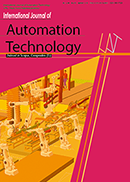Volume 16, Issue 6
Displaying 1-25 of 25 articles from this issue
- |<
- <
- 1
- >
- >|
Special Issue on Design and Manufacturing for Environmental Sustainability
-
Article type: Editorial
2022Volume 16Issue 6 Pages 683
Published: November 05, 2022
Released on J-STAGE: November 05, 2022
Download PDF (88K) -
Article type: Paper
2022Volume 16Issue 6 Pages 684-695
Published: November 05, 2022
Released on J-STAGE: November 05, 2022
Download PDF (2352K) -
Article type: Technical Paper
2022Volume 16Issue 6 Pages 696-703
Published: November 05, 2022
Released on J-STAGE: November 05, 2022
Download PDF (489K) -
Article type: Paper
2022Volume 16Issue 6 Pages 704-714
Published: November 05, 2022
Released on J-STAGE: November 05, 2022
Download PDF (371K) -
Article type: Paper
2022Volume 16Issue 6 Pages 715-726
Published: November 05, 2022
Released on J-STAGE: November 05, 2022
Download PDF (1412K) -
Article type: Paper
2022Volume 16Issue 6 Pages 727-736
Published: November 05, 2022
Released on J-STAGE: November 05, 2022
Download PDF (1461K) -
Article type: Paper
2022Volume 16Issue 6 Pages 737-746
Published: November 05, 2022
Released on J-STAGE: November 05, 2022
Download PDF (696K) -
Article type: Paper
2022Volume 16Issue 6 Pages 747-755
Published: November 05, 2022
Released on J-STAGE: November 05, 2022
Download PDF (1099K) -
Article type: Paper
2022Volume 16Issue 6 Pages 756-765
Published: November 05, 2022
Released on J-STAGE: November 05, 2022
Download PDF (1852K) -
Article type: Report
2022Volume 16Issue 6 Pages 766-772
Published: November 05, 2022
Released on J-STAGE: November 05, 2022
Download PDF (1823K) -
Article type: Paper
2022Volume 16Issue 6 Pages 773-782
Published: November 05, 2022
Released on J-STAGE: November 05, 2022
Download PDF (1854K) -
Article type: Paper
2022Volume 16Issue 6 Pages 783-794
Published: November 05, 2022
Released on J-STAGE: November 05, 2022
Download PDF (2053K) -
Article type: Paper
2022Volume 16Issue 6 Pages 795-806
Published: November 05, 2022
Released on J-STAGE: November 05, 2022
Download PDF (1190K) -
Article type: Paper
2022Volume 16Issue 6 Pages 807-813
Published: November 05, 2022
Released on J-STAGE: November 05, 2022
Download PDF (1178K) -
Article type: Paper
2022Volume 16Issue 6 Pages 814-823
Published: November 05, 2022
Released on J-STAGE: November 05, 2022
Download PDF (945K) -
Article type: Paper
2022Volume 16Issue 6 Pages 824-830
Published: November 05, 2022
Released on J-STAGE: November 05, 2022
Download PDF (146K) -
Article type: Technical Paper
2022Volume 16Issue 6 Pages 831-837
Published: November 05, 2022
Released on J-STAGE: November 05, 2022
Download PDF (1000K) -
Article type: Paper
2022Volume 16Issue 6 Pages 838-844
Published: November 05, 2022
Released on J-STAGE: November 05, 2022
Download PDF (941K) -
Article type: Technical Paper
2022Volume 16Issue 6 Pages 845-852
Published: November 05, 2022
Released on J-STAGE: November 05, 2022
Download PDF (1778K)
Regular Papers
-
Article type: Paper
2022Volume 16Issue 6 Pages 853-861
Published: November 05, 2022
Released on J-STAGE: November 05, 2022
Download PDF (4002K) -
Article type: Paper
2022Volume 16Issue 6 Pages 862-869
Published: November 05, 2022
Released on J-STAGE: November 05, 2022
Download PDF (2111K) -
Article type: Paper
2022Volume 16Issue 6 Pages 870-878
Published: November 05, 2022
Released on J-STAGE: November 05, 2022
Download PDF (3280K) -
Article type: Paper
2022Volume 16Issue 6 Pages 879-887
Published: November 05, 2022
Released on J-STAGE: November 05, 2022
Download PDF (1355K) -
Article type: Paper
2022Volume 16Issue 6 Pages 888-896
Published: November 05, 2022
Released on J-STAGE: November 05, 2022
Download PDF (2568K) -
Article type: Paper
2022Volume 16Issue 6 Pages 897-905
Published: November 05, 2022
Released on J-STAGE: November 05, 2022
Download PDF (6792K)
- |<
- <
- 1
- >
- >|
